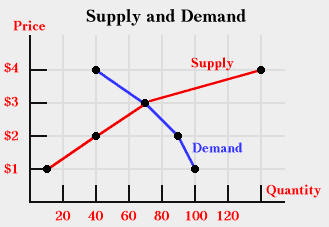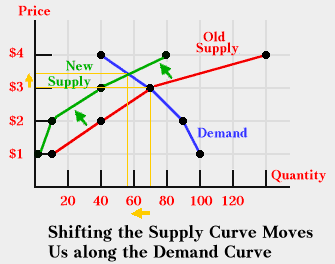The Model of Supply and Demand
To this point we have developed two behavioral statements or assertions about how people will act. The first says that the amount buyers are willing and ready to buy depends on price and other factors that are assumed constant. The second says that the amount sellers are willing and ready to sell depends on price and other factors that are assumed constant. In mathematical terms our model is
Qd = f(price, constants)
Qs = g(price, constants)
This is not a complete model. Mathematically, the problem is that we have three variables (Qd, Qs, price) and only two equations, and this system will not have a solution. To complete the system, we add a simple equation containing the equilibrium condition:
Qd = Qs.
In words, equilibrium exists if the amount sellers are willing to sell is equal to the amount buyers are willing to buy.
If we combine the supply and demand tables in earlier sections, we get the table below. It should be obvious that the price of $3.00 is the equilibrium price and the quantity of 70 is the equilibrium quantity. At any other price, sellers would want to sell a different amount than buyers want to buy.
|
Widgets |
People Want to Buy |
Sellers Want to Sell |
The same information can be shown with a graph. On the graph, the equilibrium price and quantity are indicated by the intersection of the supply and demand curves.

If one of the many factors that is being held constant changes, then equilibrium price and quantity will change. Further, if we know which factor changes, we can often predict the direction of changes, though rarely the exact magnitude. For example, the market for wheat fits the requirements of the supply and demand model quite well. Suppose there is a drought in the main wheat-producing areas of the United States. How will we show this on a supply and demand graph? Should we move the demand curve, the supply curve, or both? What will happen to equilibrium price and quantity?
A dangerous way to answer these questions is to first try to decide what will happen to price and quantity and then decide what will happen to the supply and demand curves. This is a route to disaster. Rather, one must first decide how the curves will shift, and then from the shifts in the curves decide how price and quantity would change.
What should happen as the result of the drought? One begins by asking whether buyers would change the amount they purchased if price did not change and whether sellers would change the amount sold if price did not change. On reflection, one realizes that this event will change seller behavior at the given price, but is highly unlikely to change buyer behavior (unless one assumes that more than the drought occurs, such as a change in expectations caused by the drought). Further, at any price, the drought will reduce the amount sellers will sell. Thus, the supply curve will shift to the left and the demand curve will not change. There will be a change in supply and a change in quantity demanded. The new equilibrium will have a higher price and a lower quantity. These changes are shown below.

What should one predict if a new diet calling for the consumption of two loaves of whole wheat bread sweeps through the U.S.? Again one must ask whether the behavior of buyers or sellers will change if price does not change. Reflection should tell you that it will be the behavior of buyers that will change. Buyers would want more wheat at each possible price. The demand curve shifts to the right, which results in higher equilibrium price and quantity. Sellers would also change their behavior, but only because price changed. Sellers would move along the supply curve.
Next we reflect on some assumptions we have made.
If you would like to see a QuickTime animation of a shifting supply curve, click here.
Copyright Robert Schenk